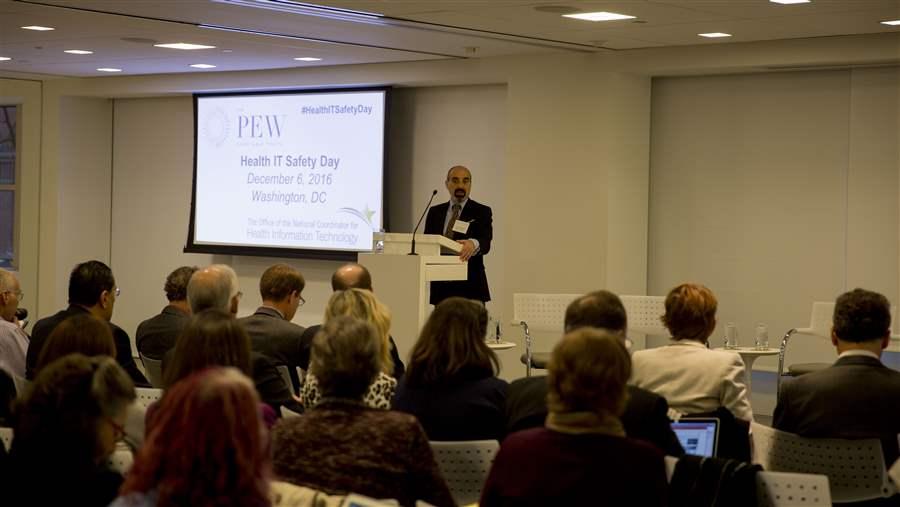Health IT Experts Identify Ways to Improve Patient Safety
Speakers at Pew-hosted event urge collaboration to address electronic health record challenges

Jon White, deputy national coordinator for health IT at the Office of the National Coordinator for Health IT, speaks at Health IT Safety Day. Also on the panel are Allan Coukell, left, senior director of health programs at Pew, and Andrew Bindman, director of the Agency for Healthcare Research and Quality.
© The Pew Charitable Trusts
Electronic health records are now an indispensable part of patient care, but the shift away from paper records has led to unintended safety problems. For example, after a doctor has brought a patient’s record to the top of the screen, some systems automatically refresh, replacing it with a different person’s record. Some electronic systems can also easily cause a clinician to prescribe the wrong medication or dosage, or miss critical information such as a pending lab result, threatening patient safety.
On Dec. 6, The Pew Charitable Trusts and the Office of the National Coordinator for Health Information Technology (ONC) co-hosted Health IT Safety Day, a meeting designed to shed light on the importance of enhancing the safety of electronic health records. Speakers from hospitals, academia, patient organizations, and the federal government discussed how the design of electronic health records can harm patients and proposed a solution: a nationwide health IT safety collaborative.

Jeff Lerner, president and CEO of the ECRI Institute, speaks at Health IT Safety Day. Also on the panel are, from left, Doug Johnston, director of health IT policy at RTI International; Michael McGinnis, executive officer at the National Academy of Medicine; Jim Russell, chief patient safety officer at Epic; and Joy Tobin, chief of health informatics at MITRE Corp.
© The Pew Charitable Trusts
Event highlights
An interactive demonstration at the event drove home to participants how design deficiencies in electronic records can affect patient safety. It included examples of how they have contributed to patient deaths, including the case of a 12-year-old boy in New York.
Speakers at the event agreed that for a health IT safety collaborative to be successful, member organizations must identify ways to encourage each group of participants to join, develop a sustainable business model, and procure seed funding from the government or other sources.
Representatives from the Federal Aviation Administration, American Airlines, and United Airlines spoke of how their industry developed a similar partnership in 1997 after a series of accidents. Through this effort, competitors had an opportunity to share information on common safety problems, near misses, and best practices. Two decades later, passenger deaths have dropped by more than 80 percent.
For more information about the health IT safety collaborative, electronic health records usability, and the Dec. 6 meeting, please see a collection of resources on the right. Links to recordings of each of the panels are below:
- Opening remarks/Panel 1: How health IT safety affects patients and providers
- Demonstration: How electronic health record usability influences patient safety
- Visions for a multistakeholder health IT partnership
- Perspectives from the aviation industry
- Readout of breakout sessions
- Stakeholder perspectives on an electronic health record safety collaborative/next steps














